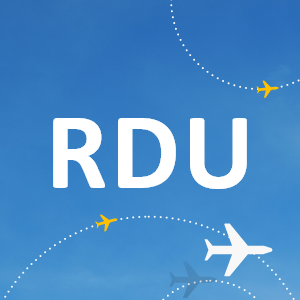
The Raleigh-Durham region in North Carolina is associated with the Research Triangle and a concentration of employment in science and technology. The presence of three major research universities makes education, innovation, and a culture of collaboration key drivers of the area’s development. Raleigh-Durham International Airport (RDU) is the second largest airport in terms of passenger traffic in North Carolina behind Charlotte Douglas International Airport (CLT). The RDU catchment area reaches roughly 4 million people. The region is included as a case study to illustrate the relation between growth in air service and increases in economic activity related to the professional, scientific, and technical (PST) sector.

Regional Economic Strengths
The region’s population and employment have grown significantly since 2008 and grown nearly twice as fast as North Carolina as a whole. The region’s per capita income is almost 20 percent higher than the statewide average.
| 2008 | 2019 | Change # | Change % | |
|---|---|---|---|---|
| Population (000s) | 1,670 | 2,080 | 410 | 25% |
| Total Employment (000s) | 1,083 | 1,380 | 297 | 27% |
The region’s economy is anchored by several large employment sectors, including a significant public sector presence with local, state, and federal employees. In the private sector, the large sectors (based on total employment in 2019) are PST, health care, and information technology. The PST sector includes services like architecture, engineering, and scientific research (e.g., life sciences, nanotechnology, and biotechnology).
Changes in Air Service
Source: Diio Schedules
Passenger activity at RDU has grown significantly since 2008 and traffic reached an all-time high in 2019. Since Delta Air Lines classified it as a “focus city,” RDU has become one of the carrier’s largest non-hub operations. The number of nonstop destinations grew from 50 in 2008 to 57 in 2019, including two European destinations—London Heathrow Airport (LHR) and Paris Charles De Gaulle Airport (CDG). RDU’s 2019 international service included Toronto’s Pearson International Airport (YYZ) and Montreal-Trudeau International Airport (YUL) along with Cancun and multiple Caribbean locations. Total seat capacity has grown since 2012.
Connectivity
The growth in new destinations and increased capacity to major markets have manifested in a robust, continuous improvement in air connectivity provided by RDU to the regional economy over the past several years. Since 2015, connectivity has grown by 36 percent (or an average rate of +8 percent per annum). This was driven in large part by expanded connectivity to western hubs like Denver, Los Angeles, San Francisco, and Seattle, as well as the introduction of service to Paris in 2016.
Analysis of Changes in Air Service and Economic Activity
Total airport origin and destination (O&D) traffic is highly correlated with PST employment in the region. As PST employment rises, so does the volume of O&D activity. Similarly, high correlations occur with other aviation-reliant industries. However, correlation does not equate to causation.
Connecting Air Service and Changing Regional Economic Activity
RDU has not typically involved the community in creating its air service development goals. The airport chooses instead to inform the community of its goals based on a strategy developed internally. RDU is striving to create a model in which it identifies the needs of the community prior to developing an air service development strategy.
Regional Stakeholders and Air Service Interests
The Economic Development Partnership of North Carolina (EDPNC) cites the vibrant regional economy and robust air service offering as key attributes for retaining local talent and attracting investment in the region.
RDU’s communications team and CEO coordinate all external outreach to community stakeholders. They believe in forging relationships with local partners and aim to capture the community sentiment regarding air service needs. In addition to EDPNC, RDU works with other local organizations such as the Research Triangle Regional Partnership, area chambers of commerce, the local convention and visitor bureaus, and Raleigh Economic Development and Innovation to connect with corporate organizations. Many market pushes have come from the community, where the community communicates that business ties exist, and there is a need for service.
Communicating the Airport’s Economic Impact
The State of North Carolina published an economic impact assessment in January 2021 and found that RDU accounted for $15.15 billion in total economic output, $518.3 million in state and local taxes, $3.5 billion in personal income, and 99,335 jobs. The airport suggests that analyses on the possible economic impact of new air service (e.g., the economic impact of a new nonstop international flight, including the generation of tax revenues to local and state governments) may have more credibility and be more influential if they are completed or sponsored by organizations separate from the airport. Such analyses could be useful in helping to convince businesses and other organizations to invest in efforts to attract new air service.
